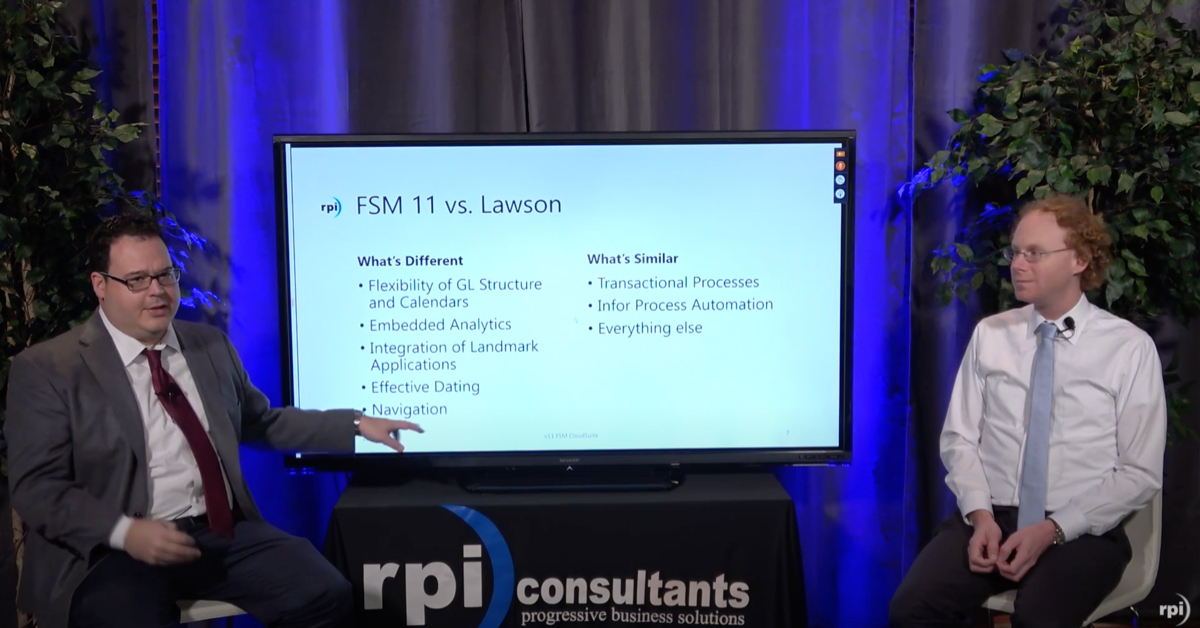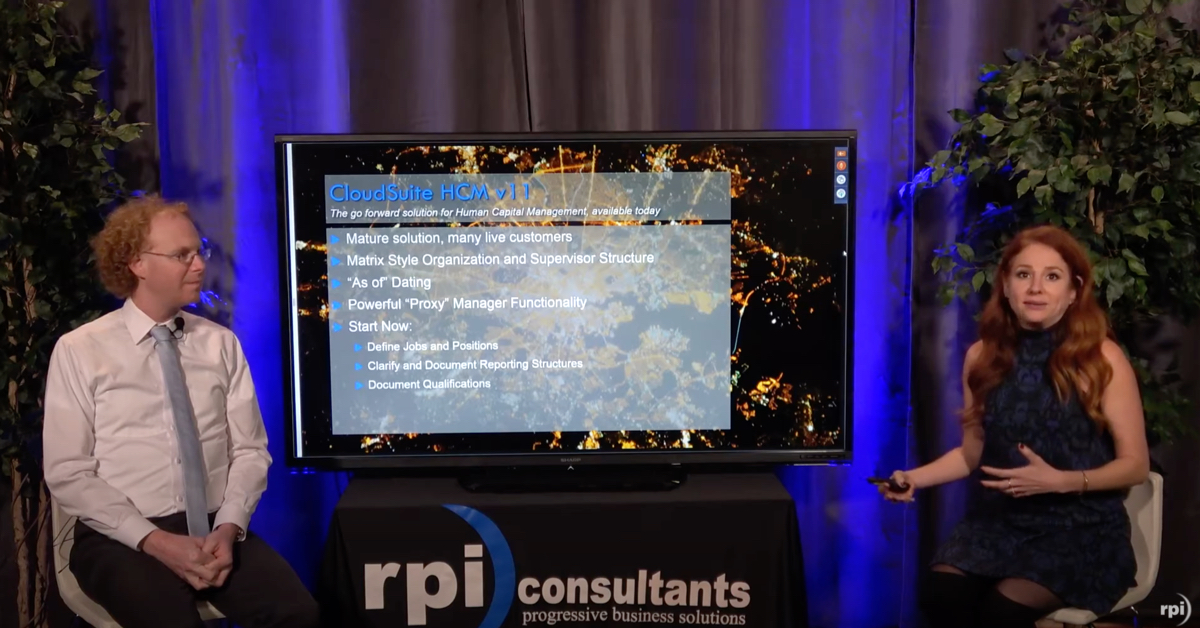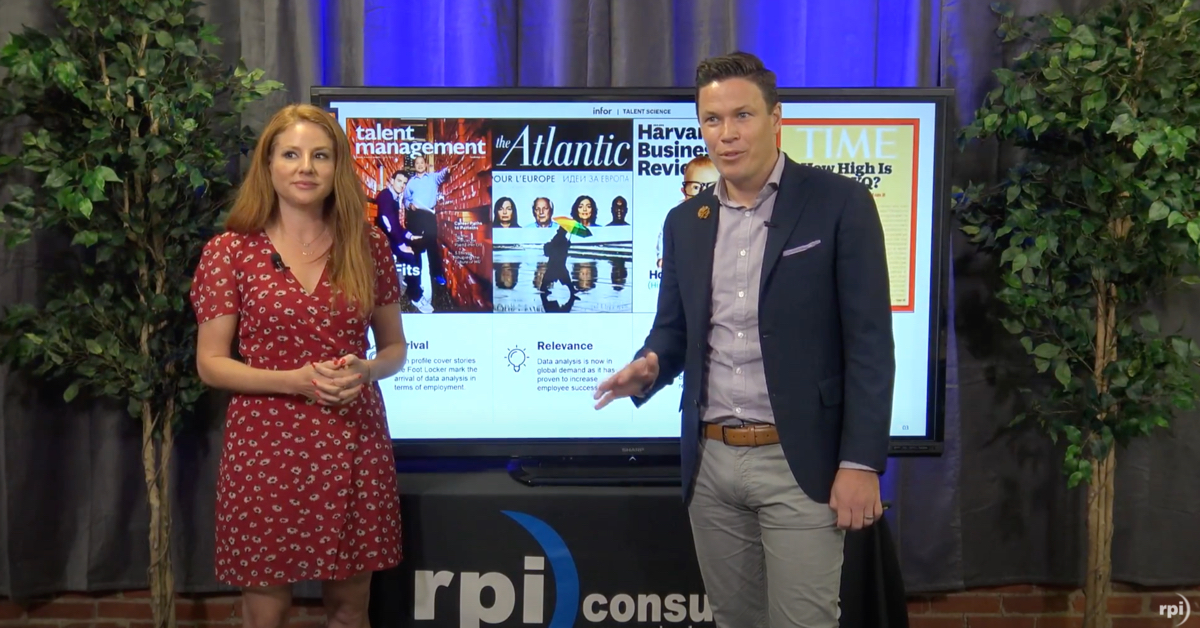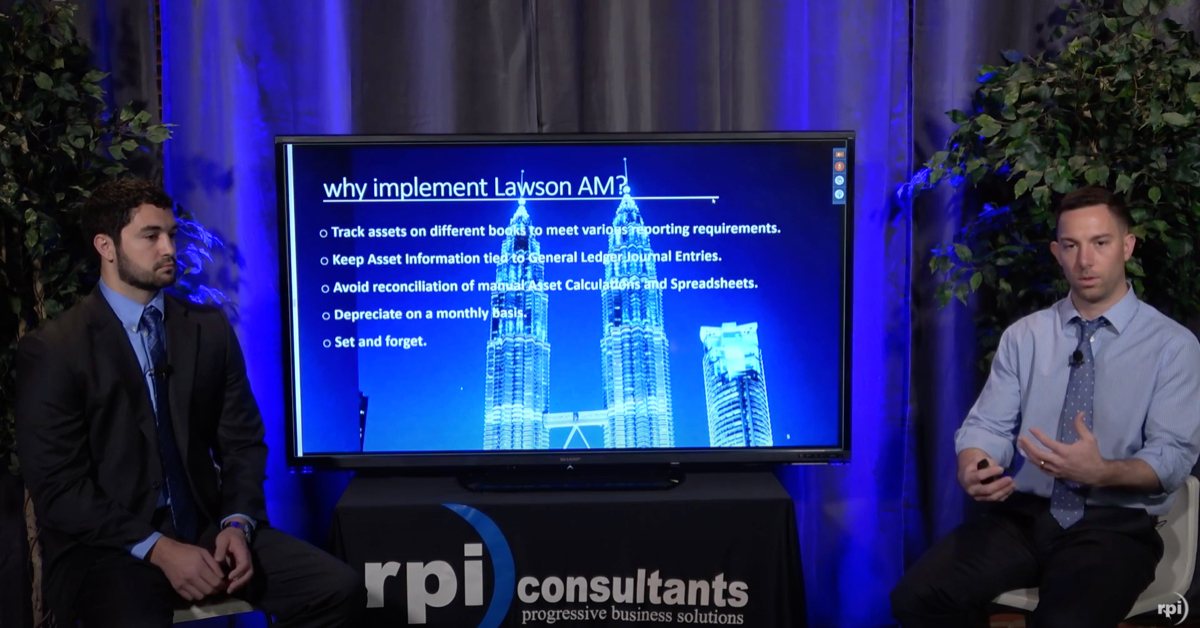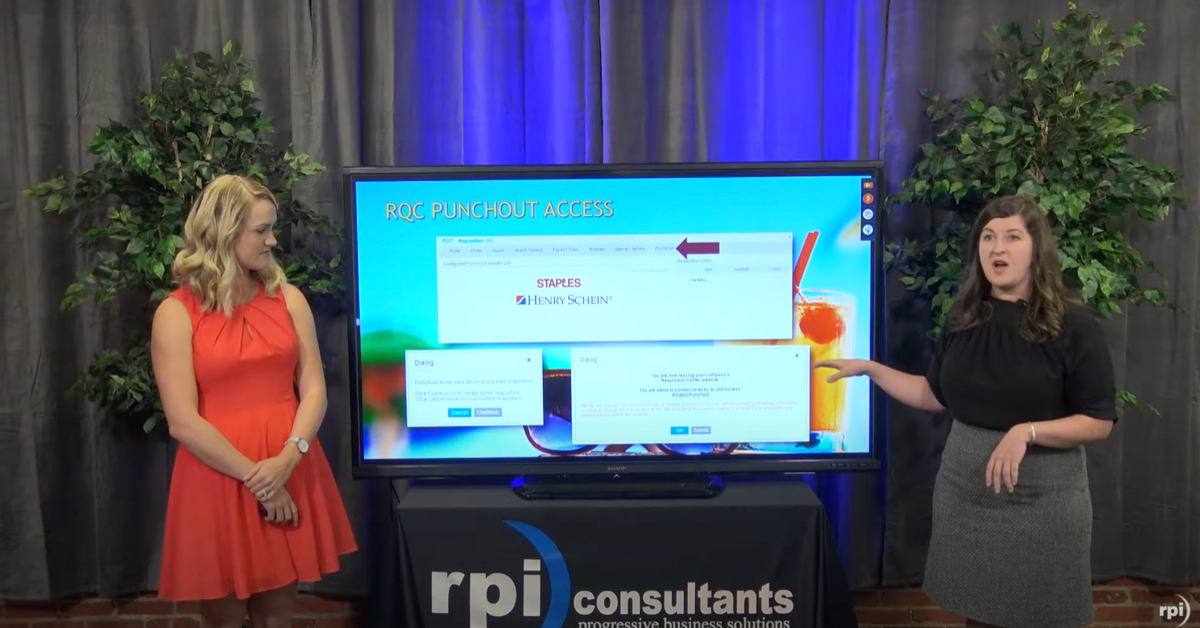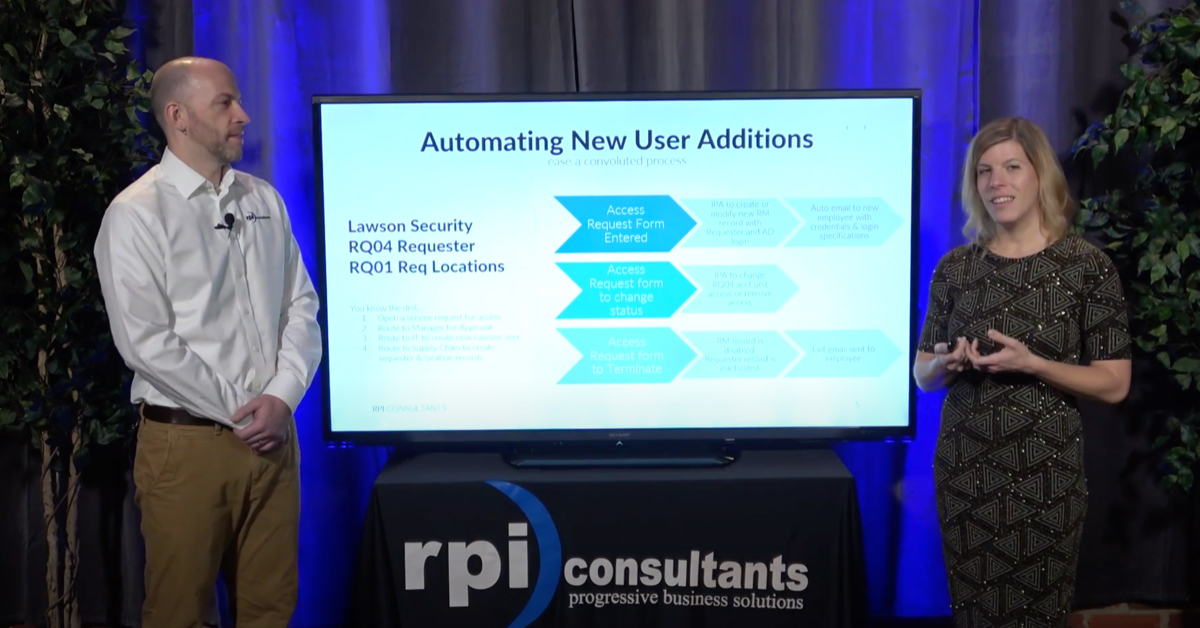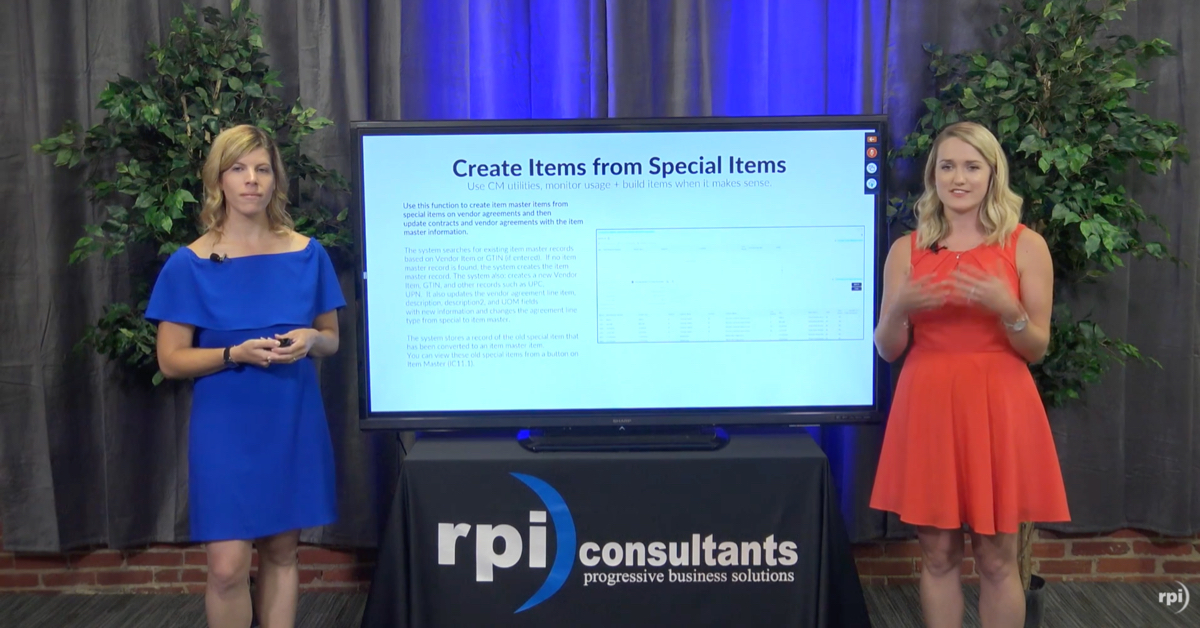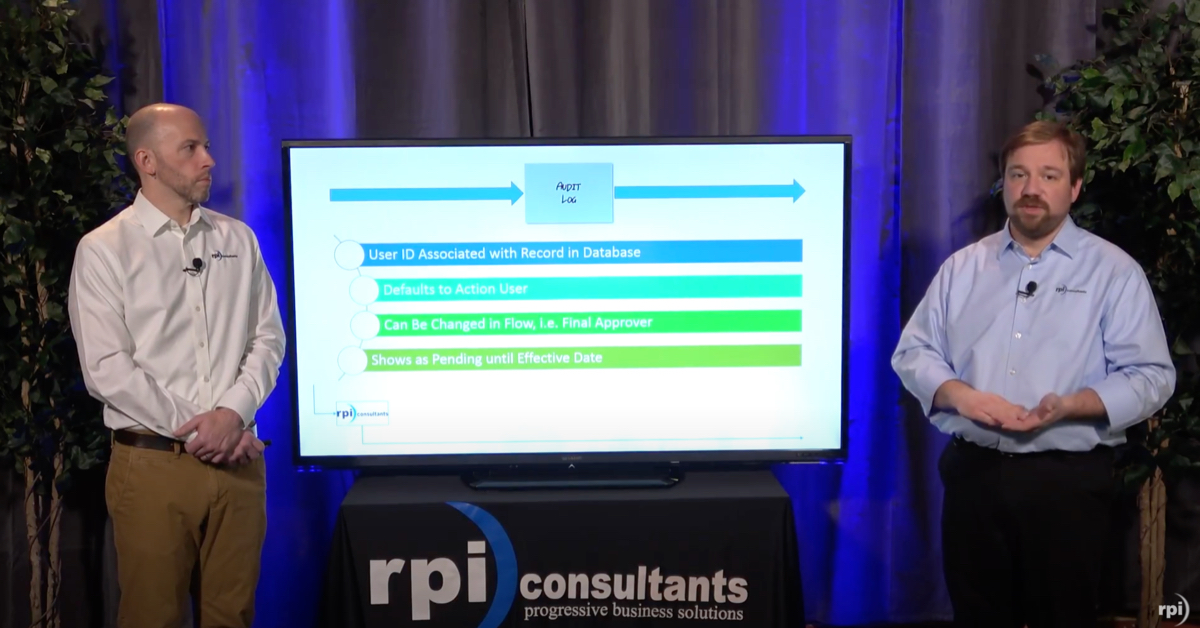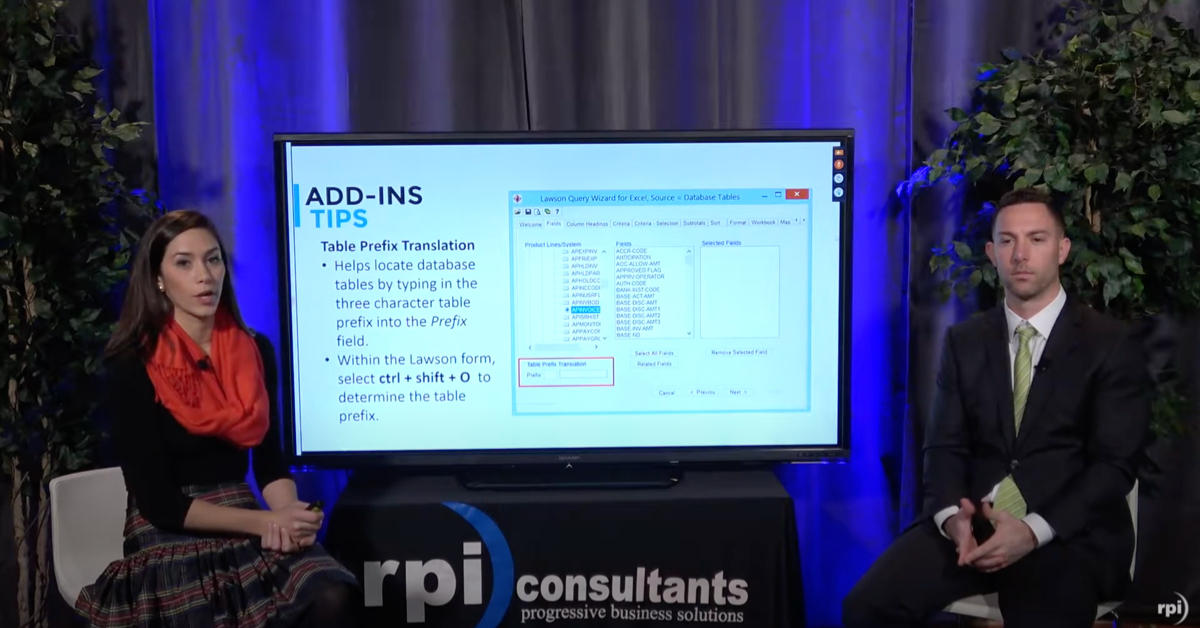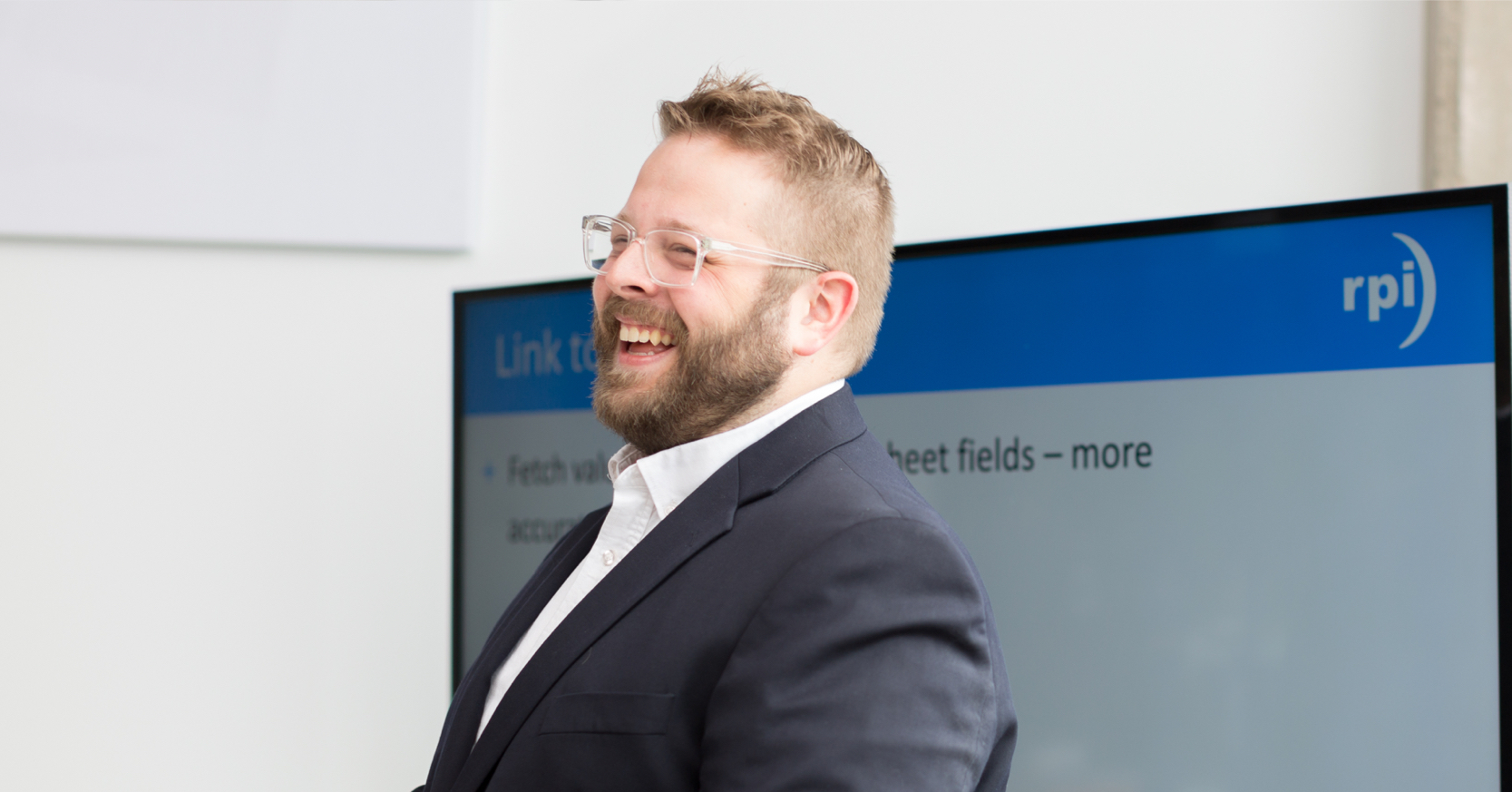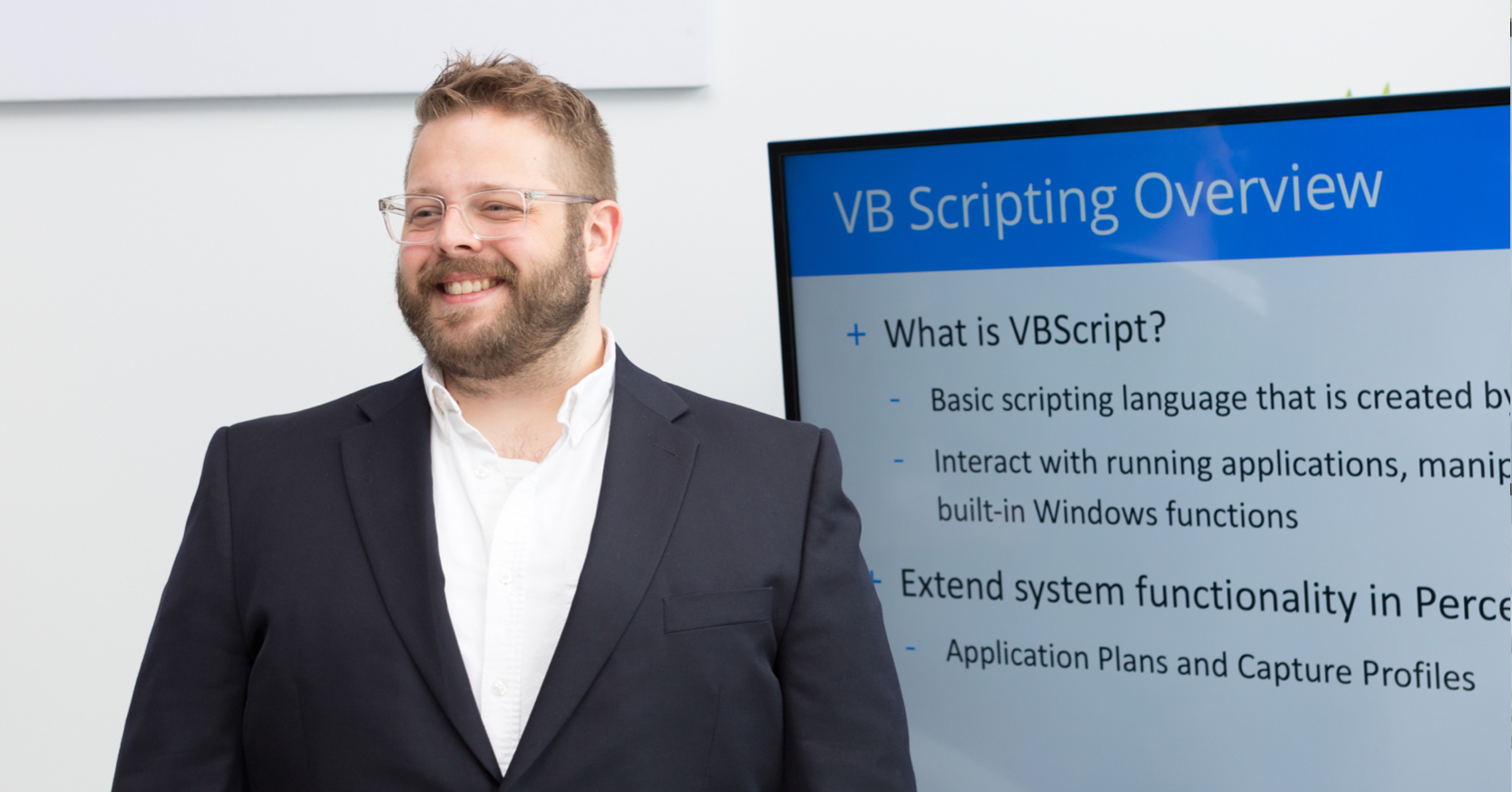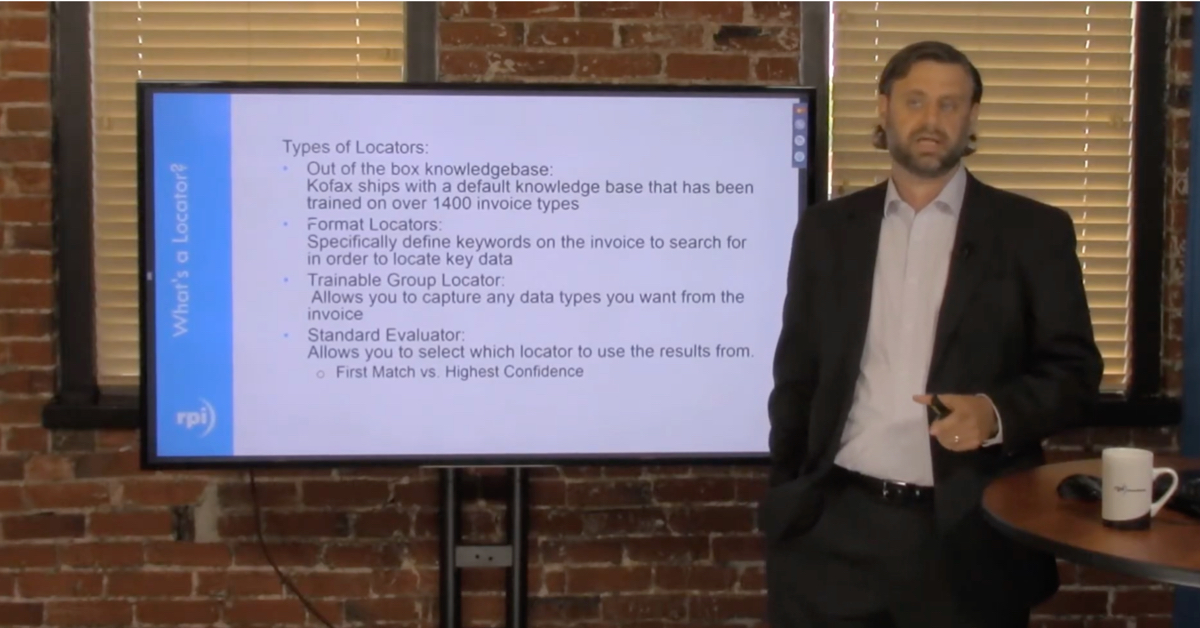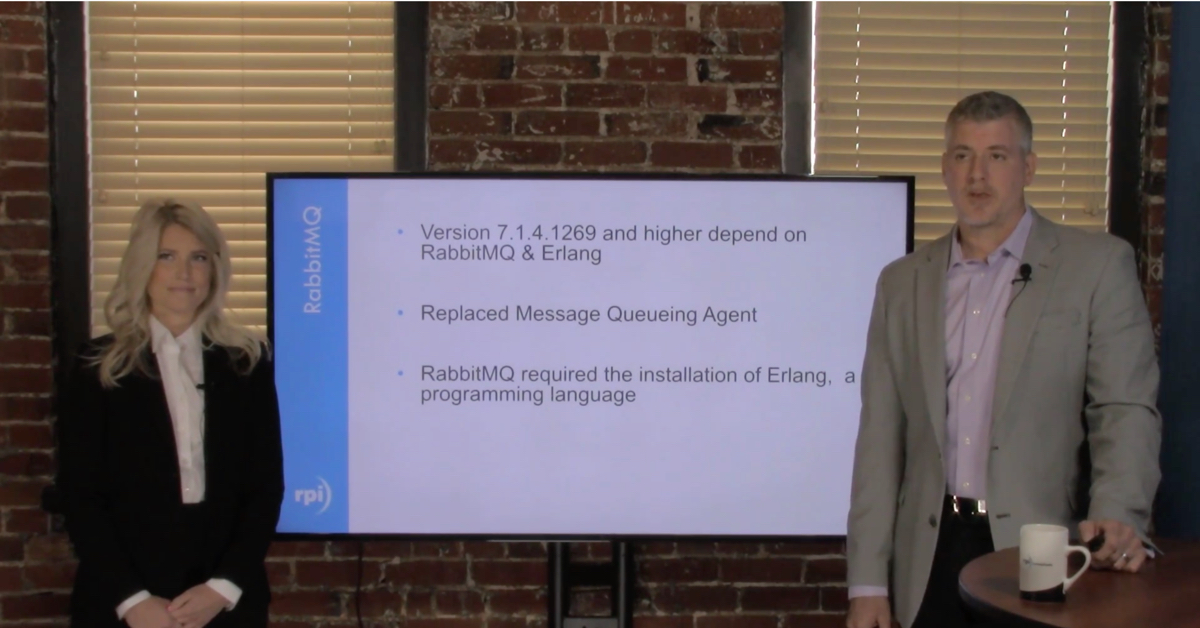Chad Tucker:
All right, everyone. Thank you for joining our webinar Wednesday here with RPI Consultants. Today, we have a webinar talking about migrating to Kofax TotalAgility from Kofax Transformation, and Kofax Capture.
We’re going to talk about some of the latest versions and features of Kofax Transformation and Kofax Capture and how those translate into Kofax TotalAgility and what different features you get from Kofax TotalAgility versus transformation and Kofax Capture.
Don’t forget to join us for some of our other upcoming webinars and office hours that we have next month. And we have the Perceptive Enhancement Pack 2 upgrade to discuss all of the features that come with that upgrade. We have another webinar, making OnBase and Infor Work Together. And then in August we have upgraded Process Director 7.8, and to talk about all the features of that upgrade. Additionally, we have some great office hours where we do some hands-on work. We have another rendition of Perceptive in ImageNow iScripts, which is a really good one. And then we have a new one with Microsoft Power Automate (Flow), so you can take advantage of your existing investment in Office365 and some of the automation tools that come with that. So today you…my name is Chad Tucker, Manager Solution Engineering. Over 10 years’ experience in process automation, formally a developer and system administrator, was in the Marines and I’m looking forward to the beach this weekend.
Alan Schefers:
Hello everyone. My name is Alan Schefers. I live here in California. I’m a golfer and a hockey fan. I was first certified in Kofax Capture way back in 2006 when it was Ascent Capture and the 4kTM. And I also have some knowledge of OnBase and Yoga.
And in today’s agenda, we’re going to basically go over what the newest versions of Kofax Capture and some of the features and also Transformation. And then Chad’s going to talk about the Kofax TotalAgility capabilities and features. The ‘Move-Up’ Program that Kofax is offering, and some of that migration considerations and planning. And then if you guys have any questions, we’ll go over any questions and have a pretty summary.
So, the latest information on Kofax Capture. Kofax Capture, as you all know, is a leading capture platform that basically does data capture, classification extraction. It can do barcodes, handprint, OMR, OCR, any kind of extraction that you need. It has a very tight integration with any kind of electronic documents through the use of the Kofax import connector. So, we can grab emails, web service calls, XML, mobile devices, faxes, if people’s still have fax machines out there. It also provides…it exports to your basic full range of ECM products, your ERPs, and your business process management and workflow solutions.
So, they’ve got all the bases covered there. The current version of the Kofax Capture is Kofax Capture 11.0.1 Service Pack 1 Fix Pack 1. And this first came out and the latest releases as of October of 2009, I believe it was the 10th. And some of the newer features, it allows you to do administrative login audits. So, you can see who’s been doing what.
Batch classes. There’s a separate database now for the user tracking statistics to run your reports. So, it doesn’t interfere with the size of your basic capture database. There’s a batch class versioning that is new. There’re some Security Boost enhancements for your active directory and single sign-on. They added a Scan Settings tab for the scanner in the scan interface and also the QC module and also the validation module. And there are some also some general enhancements for the VRS software, which is 5.1, I believe VRS elite. And they updated the ABBYY FineReader OCR engine also. And Kofax, just doesn’t really have any plans of discontinuing Kofax Capture and going strictly to KTA.
Mike:
Good.
Alan Schefers:
So, a Kofax Transformation, everyone knows that it’s an add-on to Kofax Capture, and it does a lot of the heavy lifting for your extraction and your classification. It uses a lot of machine learning and artificial intelligence to perform that work. It also improves the information visibility by use of the validation form, is customizable. So, you can add tabs, you can add buttons and do pretty much anything you want with the validation form, which wasn’t the case in original Kofax validation. You could also reduce document classification, separation and data entry costs by using the trainable document separation. And you can also have a trainable document extraction also. So, you can, as you’re processing documents, the software will learn basically. And the next time you extract or separate that document you’ll have better results as you go. There’s also, you of course do increase productivity by not having to manually validate or key from image anymore. And they’ve also increased data quality for if you use the Search and Matching server which is an out-of-the-box solution for configuring your data look ups in your validation.
So, the current version of KTM is 6.3 Service Pack 1 Fix Pack 6, and this was released last month on the 15th. So, it’s fairly new. And some of the newer enhancements in this release it, does do a natural language processing. So, you can tell the sentiment in the text, there is an enhanced barcode engine. There’s a new fuzzy search database that you can use, which is much quicker. And they added a new address locator for finding vendor addresses on documents or customer addresses. And Kofax also doesn’t have any plans on discontinuing KTM either in the near future.
So, one of the use cases here at RPI, we’ve done a lot of is invoice processing. Here’s an example of a KTM validation form that we designed. So if you look at the upper left-hand corner, it extracts the PO number and then does a look up and it tries to match whether the PO is from that specific customer for the ticket to grab the vendor information and below that is where it extracts the invoice information. As you can see under the invoice tab here, it also does line item extraction, which is on the next tab.
Chad Tucker:
One of the things I really like about this form Alan, is that we have the OCR results right next to the fields, so that you can see exactly without having to go all the way over to the invoice image. You can see right there on the fields, next to the field where it pulled that off the document. So, if it mis-transposed a zero for an O or a five for an S or a one for an I, you can easily see what’s on the image and correct without having to search for it on the invoice. It’s a pretty cool feature of this form.
Alan Schefers:
And the second tab is the line item information that is returned from a lookup that we did to the customer’s ERP system. So, if the totals match, basically we do a line item and if the totals match, then this tab automatically turns green, and it will be exported to their ERP system as a posted invoice.
Chad Tucker:
Great. So I’m going to talk to you a little bit about some of the features of Kofax TotalAgility and kind of how they compare to what you just saw in Kofax Capture and Transformation, how they translate into TotalAgility and what additional features that Kofax TotalAgility has. So, we talked about how Kofax Capture has a Scan and Import, Kofax VRS, Kofax Transformation, all these connectors for exporting your data out. Well, if that continues to live on in Kofax TotalAgility, right? You still have all those same features, but they’re integrated into a platform that has other features such as web and mobile ready forms, process orchestration, dynamic case management, business rules, and, and continue to have out-of-the-box, third party integrations that are either web service-based, exporting of flat files, XML, CSVs, inserting into databases. What have you there.
The other add on things about Kofax TotalAgility that make it unique between Kofax Capture is that as an Intelligent Automation platform, you can add these boxes in green. You can add RPA into it. You can add electronic signature, you can add the mobile web SDKs, all as part of a single integrated platform, rather than having all different tools for different items. So, we’re going to talk a little bit more about your process orchestration, your case management and the business rules, which is really one of the main additions that KTA brings to the Kofax Capture and Transformation world. And this is all done through a low-code or no-code type of configuration. I’m going to show you a little bit what the process designer looks like to build this process orchestration and, and business process workflows.
The other thing that KTA brings is a multi-tenant model. So if you’re a large organization that has several different business units that may need to be segregated from one another for legal reasons, or maybe you’re a BPO type organization, and you want to be able to provide AP as a service to your different organizations, KTA can have this multi-tenant model so that you can have one platform with multiple different tenant users in it.
And then lastly, KTA’s all web-based right? So the only thing that’s still not web based is your Transformation Designer because of the type of configuration and programming that’s needed to be done there, but everything else from the way that users interact in a system using from both a Scan and Capture standpoint, the validation form going into the case management aspect, the analytics, it’s all web driven. So it’s very easy to deploy and that’s important in today’s kind of environment where you have people working from home and you have to be able to provide these work solutions to them in a manner that’s easy to pull it, that you don’t have to have a VPN or you don’t have to install thick client software. So, it makes it very easy to enable your remote workers to work via the thin client.
So, the Cognitive Capture aspect of it, Alan touched on this a little bit, that some of this comes with capture and transformation, but some of what Kofax continues to add to the Cognitive Capture of TotalAgility. One of the newest features is Sentiment Analysis, to be able to tell whether there’s a good or bad, or happy or sad kind of sentiment to a piece of text. The other thing they’ve added in the natural language processing is entity recognition. So be able to tell…read a document and say, okay, here’s all the names in a document, or here’s all the currency references in the document, or here’s every time indemnification was mentioned in the document.
So being able to read a document and determine that only being able to read the contents of the doc, but be able to understand what’s in the document through sentiment analysis and entity recognition is a pretty neat feature that they’re adding to the, what they call the AI portion of Cognitive Capture, and these documents coming in Kofax TotalAgility has what’s called Omni Capture Capability. No matter where you’re getting information from: paper, fax, mobile devices, documents being scanned in from MFPs or being coming in through email. You’re reading from a database you’re using RPA to scrape website and portals. You can get information from any source. It is completely…there’s no source that you can’t ingest information from.
But once you ingest that information, you don’t understand it. And that’s where the machine learning, the document classification, the entity recognition, the sentiment analysis, being able to classify that document information, and then extract relevant results out of that information and validate it against your backend systems. Same thing that you are kind of used to in KC/KT but just enhanced by the continued R & D that Kofax is putting into the automation information platform. Lastly, once you do all this, you’re going to integrate it with your ERM, your CRM line of business systems as you are today. And again, there’s no limitation there, whether it’s via web services that you can configure in the process orchestration mechanism, whether it’s, writing database calls, whether it’s driving flat files, or even using RPA to input in directly in the portals, that there is no API available.
As Kofax TotalAgility has Omni Capture it also has Omni Export in the way that we can integrate with other backend systems. So, you really are opening up your ability to integrate by using this IA platform. So this is probably a familiar screen for some folks that are, that are used to using Capture, but you can see here, this is all completely web-based Capture to do all your batch processing document classification, doc typing, maybe some, folder level indexing here, but this is all web based captured, no thick client needed for the Cognitive Capture.
The next thing that’s really important that I’ve been talking about a lot with KTA is process orchestration. So the ability to have case management and have documents live through a lifecycle that’s driven by business rules that you need to adhere to, whether it’s legal business rules are to make sure that you have certain SLAs that you have to meet. Kofax TotalAgility, with this process orchestration tool is able to add that layer into your capture platform. So instead of having to just do capture and transformation, and then send it onto your line of business systems or other workflow systems, kind of like you are today, you kind of have this all in a single place, so that you eliminate the number of integrations you have captured throughout the entire portion of the process.
So, say there’s processes where you have driver documents to start a process, but later on, you have to capture additional documentation. You’re able to continue to add the classification, continue to add the document transformation and data extraction in the middle of the process, instead of just at the front end of the process. And then also integrating it with the other Intelligent Automation tools like the e-signature RPA, all working across the organization to provide a consistent process driven by whatever the requirements are. So, I’m really excited about adding this into the Capture and Transformation ecosystem and having this as part of the entire platform.
The process orchestration, you can see it’s very drag and drop workflow style type configuration. So, this is what we mean by to no-low-code. The low-code aspect is maybe you have to do some conditions, right? If some, some simple, “if this, then that” kind of statements, or maybe some regular expressions, but you don’t have to code all this logic. You can drag and drop and just have kind of true false kind of checks, decision points that if this condition is true, then do this. If it’s false, then do this and continue to have those activities happen in the process, whether it’s doing scanning at the beginning of the process or doing scanning in the middle or at the, at the end of a process, you can incorporate document classification, document extraction anywhere, not just as a single standalone item anymore.
Here’s where you’d be able to also drop in RPA integration, the document signature integration, or any of our pre-built connectors that we have for that Kofax and we have for KTA. And also, you’re able to find pre-built connectors on the smart hubs as well, that Kofax has. So, there’s a lot of great tools that’s being built for Kofax TotalAgility, and to make it easier to integrate with existing systems today that you don’t have to build out-of-the-box.
Lastly, the thing that I wanted to show about Kofax TotalAgility is the other out-of-the-box analytics. So, on top of having…one of the important things about having process orchestration inside of your capture platform, is that now you’re able to monitor the work activities that are happening a little easier and able to report on those using Kofax analytics. So here we have a sample dashboard we’re showing “session time by user,” right? And this can be any type of activity that’s going on from classifications, your typical document classification and extraction activities, or maybe their case management activities, where they have it open, and they’re working on an item.
You can see how long it’s sitting in certain queues, how long it’s sitting certain work activities, how many are being processed, and this is an out-of-the-box kind of dashboard that comes with Kofax TotalAgility. So, you get a lot of great insight into your processes that you’re building without having to do a customization to a report to get that information it’s being dynamically built based on the processes that you’re building. So, having insightful analytics across the entire platform, I think is another great feature that Kofax TotalAgility brings that is different than Kofax Capture and Transformation.
Some additional benefits, you have more Granular Security for Capture and Extraction process activities. And the reason this is important is that maybe you want to expand your document capture outside of AP, that you’re using it for today. You want to capture HR documents. You want to capture medical records documents through the software that you already have while being able to add Granular Security allows you to fall in line with HIPAA requirements, how it allows you to fall in line with your internal PHI requirements that you can say, “Okay, only HR users can access this portion of the process and do these kind of scan documents. Only medical records staff can access this portion of it.” So, having this more granular security, if you’re capturing extraction process activities allows you to avail to expand this platform across other business areas than maybe just AP across the enterprise.
The true BPM and Case Management and a single application is like I’ve talked about already is a huge benefit that you don’t have to send all this data and integrate it to another third-party system. Sometimes data gets lost in those integrations. Sometimes if one of those systems upgrades, you have to back port certain items to capture a transformation to make it work for this other system. So, having this…consolidating into a single system for your capturing your case management, just kind of alleviates that burden of having multiple platforms. And then the true benefit is just access to the Intelligent Automation platform like the other third party…the other add-ons that you have for RPA, the e-signature and the content creation platform is just going to help you automate further. It gives you the opportunity to automate other things in your business that you may not be thinking about automating today, just using Kofax Capture and Kofax Transformation.
Alan Schefers:
So, the Kofax TotalAgility mobile ‘Move-Up’ Program. Kofax wanted to give its Capture users and its Transformation users a way to, not inexpensively, but a way to enjoy the benefits of KTA. And one of the key considerations is they’re giving 70% off KTA licenses, and it allows them to access…you to access the Intelligent Automation platform. You do have to trade in your existing licenses, but the nice thing about it is they give you a full year to use both products. So, you can take your time and develop your KTA software so that it captures everything that you’re doing already, KTM and Capture, but also you can explore some of the other benefits that it might give you.
So, what is the timing and eligibility? To be eligible you just have to be current, basically on your Kofax Capture and Transformation maintenance for also for the eFlow, ReadSoft Documents, Forms, and Xbound. It doesn’t apply to purchases, that you just did as of April 1st. Anything before then would be eligible and you have to migrate your whole system. It can’t be just a part, if you have multiple licenses, it has to be for all of the licenses that you want for capturing KTM.
Chad Tucker:
So, some migration planning and considerations that you have to think about with KTA. One of the biggest ones to consider is the environment that you have. So KTA does have generally a bigger technical footprint than Kofax Capture and Transformation. So, to be able to have all these different things, it’s typically broken out into your web tier, your app tier and your data tier. So, web tier runs the customer facing side of things that your end users are going to see what your processes are. They’re going to see what your…if you have external facing clients that are using this, they’re going to see everything on the web tier. So, depending on the size of your system, size of your footprint, the volume of what you’re using this for, you have to consider potentially one or multiple load balanced servers on the web tier. Same thing on the app tier it has a process orchestration component.
Now that is, that is pretty robust on top of the transformation service, you have your import export services, your reporting services. So, depending on, again, size and volume of what you’re running, you may have to consider multiple load balanced application servers to run these different components. So, what, you could be a single or two server environment that you’re running today in Kofax Capture and Transformation could expand into a four or five server environment to run all the components. So, it is flexible, right? If you do have a small environment, you could still potentially run everything on a single server, pending port contention and things like that. But part of what we help do in our migration assessment that we’re going to talk about here in a little bit is help architect what it would look like for you to move up from capture and Transformation to TotalAgility.
Alan Schefers:
So, the KC and the KT project migration, there is a tool that is offered in KTA that will migrate your current KTM project for the classification and extraction sets. And some of your documents will probably have to be retrained. And there are some tweaks to the projects that may need to be moved for the most part. And there are some new automation features that you might want to consider during the migration.
Chad Tucker:
Yep. So as part of the migration assessment we want to make sure is a migration, right for you, right? Are you upgrading in 2020, your version of code or capture? Maybe it’s time to assess whether migrating is right for you instead of upgrading to the latest version. Have you expanded your Kofax Capture and Transformation usage over the years and, you…is your business heavily reliant on it? So there there’s a lot of things to consider. Is it right for you? And RPI is happy to provide a migration assessment engagement to map out what a migration looked like from a technical architecture standpoint, a services standpoint, and kind of what a cost benefit analysis would look like of going from, from KC/KT to KTA.
So that’s it for a high-level content of migrating. We appreciate you joining here. This webinar has been recorded, and we’re going to put it online on our, on our webinar website. Any further questions about migrating or wanting to talk to someone about KTA or the challenges and opportunities of migrating. Go ahead and email us at [email protected], and we’re going to pause here for a moment and take any questions that we have from the presentation.
Mike, I’m assuming there’s no questions.
Mike:
Yep. None are coming in; we can go ahead and move on.
Chad Tucker:
Okay. Additional resources. Like I said, we have a page dedicated webinars. We have a product and solution knowledge base that we post videos and blog articles to. And then our Kofax website for our Kofax Services and Solutions. And again, don’t forget our upcoming webinars and office hours that we have this month and next month. And just a little bit more about RPI consultants, not only do we work with Kofax, we’re also a Hyland Authorized Solution Provider, Infor CloudSuite Alliance Partner and have over a hundred full-time consultants out of Baltimore, Tampa, Kansas city, and across the United States that provide technical and professional services on all the products that we are vendor partners for. Thanks again for joining. And we look forward to seeing you in our future webinars.
Mike:
Thank you.











